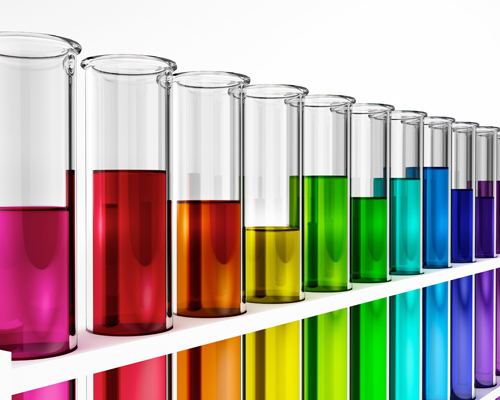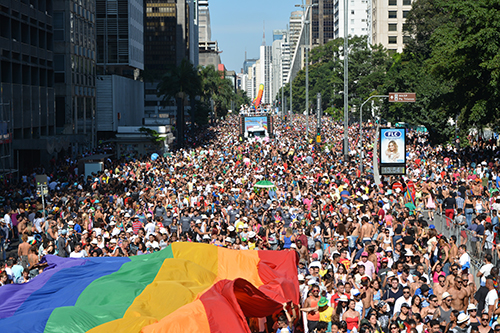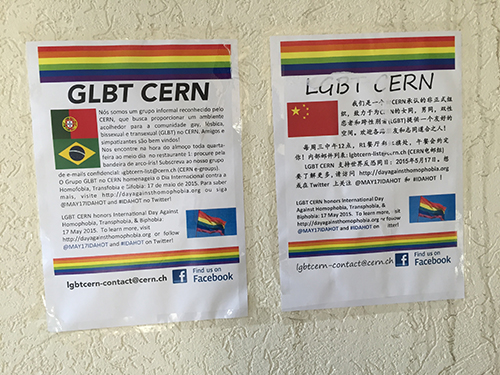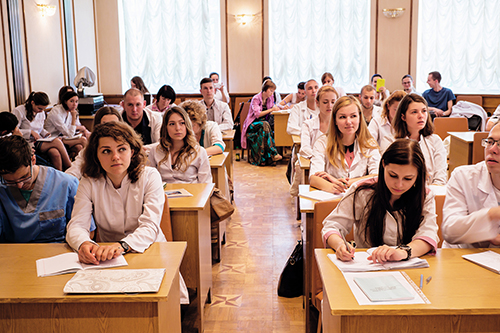Where are all the LGBT scientists? Sexuality and gender identity in science Inspire article
Do LGBT scientists feel they can be ‘out and proud’ at work? A biophysicist reflects on his own and other LGBT scientists’ experiences.

wunschmedien.de /
shutterstock
Careers in science are not traditional tracks that LGBT (lesbian, gay, bisexual and transgender) people pursue. Certainly this is the image presented by the media, where LGBT people are often portrayed as working in the entertainment and fashion industries. Lists of powerful LGBT individuals confirm this image: for example, a UK newspaper’s World Pride Power List in 2014w1 contained only one person – out of 100 – in a science-related occupation: a celebrity doctor. This seems striking, even taking into account the low visibility of science in popular media generally.
My own story reflects this. In the Philippines, where I grew up, being gay is often connected to working as a hairdresser or serving as comic relief in shows and movies. This stereotype of LGBT people didn’t appeal to me. In primary school, I was the nerdy, fat kid, and I got my share of bullying for being different. However, being nerdy also meant that I got good grades – good enough to get me into a prestigious high school.
At the Philippine Science High School, students were extensively trained in mathematics and science and were encouraged to take STEM (science, technology, engineering and maths) courses at university. We thrived in an environment that celebrated critical thinking and self-expression, and I gained self-esteem and confidence in being different – and in being gay, which helped me come out, initially to a few friends.
I officially came out in 2003 while in university, where I was able to express myself openly in an accepting environment. After obtaining my bachelor’s and master’s degrees, I moved from the Philippines to Heidelberg, Germany, for my PhD. This move initially made me wonder how gay-friendly Germany would be, but fortunately it was not a problem, and I have even found LGBT mentors and friends in the scientific community.
So while I am personally able to live and work in an accepting environment, I often ask myself: is this the same for most gay people? Where are the other LGBT scientists? I decided to find out, and to ask these scientists to tell me their own stories.

Image courtesy of Ben Tavener; image source: Flickr
Sarah’s story
Professor Sarah Veatch, an assistant professor of biophysics and physics at the University of Michigan, USA, came out early in her career. She was involved in her high school’s gay-straight alliance in the mid-1990s, but still struggled with her LGBT identity until college at the Massachusetts Institute of Technology (MIT).
At MIT, Sarah started playing rugby, which helped her come to terms with her identity, as she found it easy to fit in as “one of the guys”. In a male-dominated class, her more masculine demeanour helped put her on an equal footing with male classmates and also discouraged romantic interactions. Today, she feels this same approach helps her interactions with colleagues now that she is in a more senior scientific position. Physics, after all, is still male-dominated.
Many of her straight women peers worried about balancing family life with their scientific careers. But Sarah was never much concerned about this issue, as it didn’t occur to her that she would one day be in a family playing a traditional gender role. Today, this issue is more complex as there are many options for same-sex couples to have children, although laws protecting the rights of same-sex couples are not yet adequate in many places.
Overall, Sarah is optimistic. “Society’s perception of the LGBT community has changed a lot since I was deciding to pursue a career in academic science”, she concludes. “It is much more mainstream [now], and I have benefitted from this.”
David’s story
Professor David Smith’s experience was mixed: he didn’t feel able to come out as LGBT when he was growing up, but he faced few problems in the workplace once he did so.
When David was growing up in the UK in the 1980s, the atmosphere towards LGBT people was threatening and unwelcoming. “I witnessed homophobic slurs regularly, and would not have even considered coming out or exploring my sexuality”, he says. While at secondary school, he didn’t quite understand his LGBT identity because it was such a taboo to discuss it even with friends. This resulted in him not coming out until much later in his career, once he had obtained an academic position.
David, who currently works on supramolecular chemistry at the University of York in the UK, says he has not really experienced explicit homophobia in science. He says, “I would say scientists don’t care that I am gay; it’s a career I can thrive in.” He is an advocate of more accessible science, and he has a YouTube channelw2 where he uploads chemistry tutorials on everything from chocolate and curry to drugs.
David also gives seminars and writes about the importance of the visibility of LGBT scientists, as he believes visible LGBT role models capture the diverse experiences of different people and show young people what’s possible for them. “It’s easier to relate to someone who may have gone through the same experience”, he says.
Pauline’s story
Many scientists are still afraid to come out in the workplace – and these fears are not unfounded, as Pauline Gagnon experienced. She studied in Montreal, Canada, and moved to the University of California in Santa Cruz, USA, for her PhD. Afterwards, Pauline obtained a position in Ottawa, Canada, and later at Indiana University, USA, which led her to work at CERN, in Switzerland. There, she worked on the ATLAS experiment, one of the experiments that famously confirmed the existence of the Higgs boson.
“I was completely out in California and Canada,” she recalls, “but moving to CERN [in 1999], I experienced a different culture. It was more conservative there.” She relates feeling excluded and discriminated against because of her sexual orientation. Several years later, however, some dynamic young people started an LGBT social group in CERN. “Having such a group made a difference; joining the LGBT group was a breath of fresh air”, she says.

Image courtesy of Rolf Landua
Aside from her scientific publications, Pauline has written a popular science bookw3 on particle physics and gender and sexuality issues in science, and she speaks publicly about women and diversity in science. “The best protection against homophobia is being out”, she says. “Being out means I have nothing to hide; there’s nothing wrong with me.” Pauline believes that the more LGBT people are out, the faster attitudes will improve. “I paid a high price for it, but I could not have lived closeted”, she says.
The president of the LGBT group at CERN, Alex Brown, also believes that the group’s existence marks a change for the better, but cautions that changing attitudes does take time. To help achieve this, he would like to see more visible support for LGBT rights from non-LGBT people – not just at CERN, but more generally. “It means a lot to know we have allies who are prepared not only to accept us, but also to openly welcome us”, he says. Alex believes that teachers can be key to nurturing this acceptance. “Teachers play such an important role in shaping society’s future. I only wish there were more authentic, high-quality resources to better equip them to teach about what can be a sensitive subject.”
Reflections
Sarah, David, Pauline, Alex and I experienced life in the sciences during different decades and this shows in our varied experiences. The suffering of earlier generations has helped to make being LGBT more acceptable today – but this does not mean that there is no more work to be done.
In the STEM fields, a lot of scientists don’t see being LGBT as a hindrance, but some also prefer not to discuss it. “I feel like my being [gay] is a non-issue; it’s not something I talk about explicitly”, says Sarah. David thinks that this might reflect a ‘don’t ask, don’t tell’ attitude in science. “[Senior scientists] often say – what does it matter? All that I judge is the science”, he says. “Many scientists say that they do not want to hear about people’s personal lives.”
But is there something to gain if we talk about these issues openly? I believe there is. A supportive environment helps in work-life balance – nourishing scientists and allowing them to concentrate on the science, instead of thinking about how to keep themselves protected from discrimination.

Image courtesy of BoxerX / shutterstock
So how do we bring about this supportive environment? Growing up at a time where being LGBT had a negative stigma, David says that it would have helped him to have a teacher who was a point of contact for students with LGBT issues. While he had many teachers who made a huge difference in his scientific development and his decision to study science, this was not related to finding his LGBT identity. To explore this idea, David carried out an informal survey at York, which revealed that LGBT students do value the presence of an LGBT role model in their department. “This enables them to find a safe and supportive environment”, David says.
Of course, the visible presence of LGBT scientists doesn’t directly equate to recruiting the younger LGBT generation to science. But as well as providing a more comfortable environment, it helps young LGBT people to find someone they can aspire to be – just as girls may be inspired by Marie Curie, as indeed Pauline was.
And while any inquisitive young person – LGBT or non-LGBT – might find themselves in a science career, today’s LGBT scientists still need to be visible. “It is not enough to be simply out”, Pauline concludes. “We have to be visible. Science has a lot to gain with diversity, because we come with our own creativity, and creativity is essential to science.”
Web References
- w1 – The Guardian’s World Pride Power List 2014 celebrated the achievements of influential LGBT people.
- w2 – For David Smith’s YouTube channel, see: www.youtube.com/user/ProfessorDaveatYork
- w3 – Learn more about Pauline Gagnon’s book, Who Cares about Particle Physics: Making Sense of the Higgs Boson, Large Hadron Collider and CERN.
Resources
- The UK newspaper The Independent published its Rainbow List 2015 of the ‘101 most influential lesbian, gay, bisexual, transgender and intersex people in Britain’.
- For an article by David Smith reflecting on being a gay scientist, see ‘No sexuality please, we’re scientists’ on the Chemistry World website.
- For a schoolteacher’s reflections on the experience of being a gay pupil, see ‘Schools have come a long way since I was a gay pupil’ on The Guardian website.
- For two schoolteachers’ experiences (one positive, one negative) of being openly gay in the workplace, see:
- ‘Secret Teacher: I’m my school’s go-to gay guy’ on the The Guardian website.
- ‘Secret Teacher: my school tried to stop me being openly gay’ on The Guardian website.
- The Queer in STEM website offers a study of sexualities and gender diversity in science.
- Visit the website of the USA’s National Organization of Gay and Lesbian Scientists and Technical Professionals.
- oSTEM (Out in Science, Technology, Engineering and Mathematics) is a US society to support LGBT scientists.
- The lgbt+physicists website helps young LGBT physicists to find mentors.
Review
In our modern world, we should embrace diversity in all aspects of life, including studies and careers. This article may give students and teachers pause for thought about issues they had not previously considered. The experiences described show that, although we live in an ‘open’ society, people may still need encouragement to be true to themselves.
Marie Walsh, Republic of Ireland





